Submitted:
26 October 2023
Posted:
27 October 2023
You are already at the latest version
Abstract
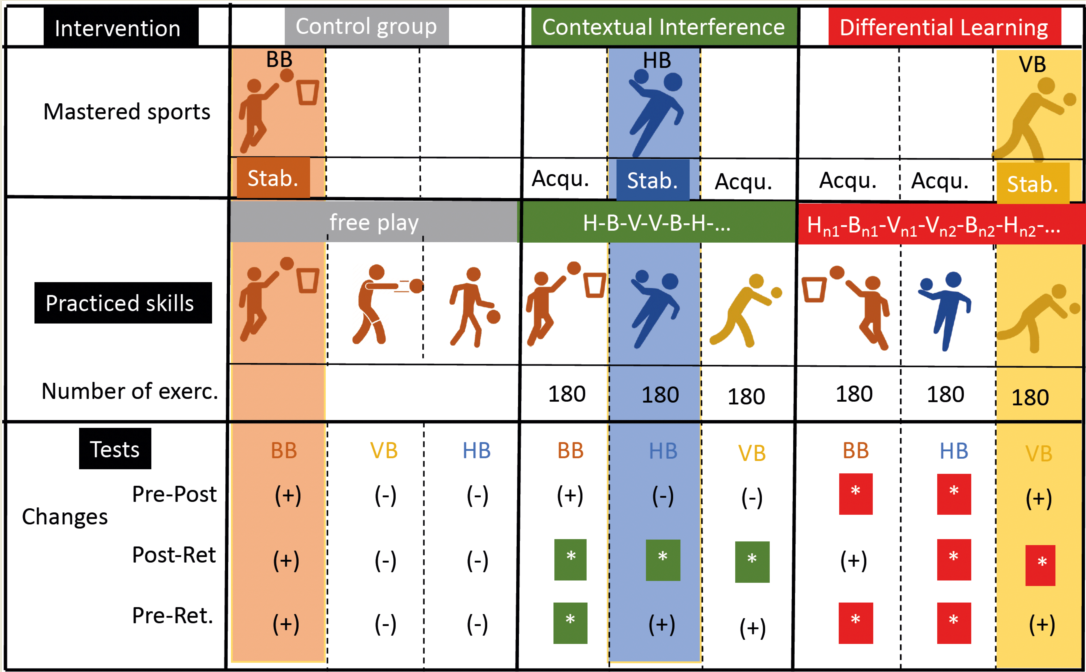
Keywords:
1. Introduction
2. Materials and Methods
2.1. Participants
2.2. Experimental Design
2.3. Test Design
2.3.1. Test 1 A: Handball shooting
2.3.2. Test 1B: Basketball free throw
2.3.3. Test 1 C: Volleyball Underarm Pass
2.4. Training-Interventions
2.5. Data analysis
3. Results
3.1. Comparative analysis across single skills
3.2. Comparative analysis across the composite score
3.3. Comparative analysis across the short-term and relatively permanent gains
3.3.1. Group effect on the short-term gain (Δ pre-post)
3.3.2. Group effect on the relatively permanent gain (Δ post-retention and Δ pre-retention)
4. Discussion
5. Conclusions
Author Contributions
Institutional Review Board Statement
Informed Consent Statement
Acknowledgments
Conflicts of Interest
References
- Van Rossum, JH. Schmidt’s schema theory: The empirical base of the variability of practice hypothesis: A critical analysis. Human Movement Science. 1990.9, 387–435. [CrossRef]
- Buszard T, Reid M, Krause L, Kovalchik S, Farrow D. Quantifying Contextual Interference and Its Effect on Skill Transfer in Skilled Youth Tennis Players. Front Psychol. 2017;8: 1931. [CrossRef]
- 3. Newell KM, Kugler PN, Van Emmerik REA, Mcdonald PV. Search strategies and the acquisition of coordination. In Advances in Psychology: Perspectives on the Coordination of Movement. Wallace, S., Ed.; North-Holland: Amsterdam, The Netherlands,; 1989.
- Brady, F. Contextual Interference: A Meta-Analytic Study. Perceptual and Motor Skills. 2004;99: 116–126. [CrossRef]
- Morrison S, Newell KM. Strength training as a dynamical model of motor learning. Journal of Sports Sciences. 2023. 41(5):408–423. [CrossRef]
- Ammar A, Trabelsi K, Boujelbane M, Boukhris O G, Jordan C H, Schöllhorn WI. The myth of contextual interference learning benefit in sports practice: A systematic review and meta-analysis.Educational research review :2023.100537. [CrossRef]
- Schmidt, RA. Motor Schema Theory after 27 Years: Reflections and Implications for a New Theory. Research Quarterly for Exercise and Sport. 2003;74: 366–375. [CrossRef]
- Schöllhorn WI, Rizzi N, Slapšinskaitė-Dackevičienė A, Leite N. Always Pay Attention to Which Model of Motor Learning You Are Using. International Journal of Environmental Research and Public Health 2022;19: 711. [CrossRef]
- Wulf G, Shea CH. Principles derived from the study of simple skills do not generalize to complex skill learning. Psychonomic Bulletin and Review. 2002. 185–211. [CrossRef]
- Nitsch JR, Hackfort D. Chapter 2 - Theoretical Framework of Performance Psychology: An Action Theory Perspective. In: Raab M, Lobinger B, Hoffmann S, Pizzera A, Laborde S, editors. Performance Psychology. San Diego: Academic Press; 2016.p 11–29. [CrossRef]
- Lewin, K. Principles of Topological Psychology. New York: McGraw-Hill; 1936.
- Newell, KM. Constraints on the development of coordination. In: Wade M, Whiting H, editors. Motor development in children: Aspects of coordination and control. Boston, MA: Martinus Nijhoff; 1989. p. 341–360.
- Raviv L, Lupyan G, Green SC. How variability shapes learning and generalization: Trends Cogn Sci. 2022 6:462-483. [CrossRef] [PubMed]
- Miller G, Galanter E, Pribram K. Plans and the structure of behavior. New York, NY: Holt, Rhinehart, & Winston; 1960.
- Wiener, N. Cybernetics or Control and Communication in the Animal and the Machine. Cambridge, MA, USA: The Technology Press; 1948.
- Adams, JA. Historical Review and Appraisal of Research on the Learning, Retention, and Transfer of Human Motor Skills. Psychological Bulletin. 1987;101: 41–74. [CrossRef]
- Schmidt, RA. A schema theory of discrete motor skill learning. Psychological Review. 1975;82: 225–260.
- Battig, WF. The flexibility of human memory. In: Cermak LS, Craik FI, editors. Levels of processing in human memory. Hillsdale, NJ: Erlbaum; 1979. pp. 23–44.
- Shea JB, Morgan RL. Contextual interference effects on the acquisition, retention, and transfer of a motor skill. Journal of Experimental Psychology: Human Learning and Memory. 1979;5: 179–187. [CrossRef]
- Kerr R, Booth B. Specific and Varied Practice of Motor Skill. Percept Motor Skills. 1978;46: 395–401. [CrossRef]
- Harre, D. Trainingslehre. Berlin: Sportverlag; 1969.
- Wood CA, Ging CA. The Role of Interference and Task Similarity on the Acquisition, Retention, and Transfer of Simple Motor Skills. Research Quarterly for Exercise and Sport. 1991;62: 18–26. [CrossRef]
- Wulf G, Lee TD. Contextual interference in movements of the same class: Differential effects on program and parameter learning. J. Mot. Behav. 1993;25: 254–263. [CrossRef]
- Shea JB, Zimny ST. Context effects in memory and learning movement information. In: Magill RA, editor. Memory and control of action. New York, NY: North-Holland; 1983. pp. 345–366.
- Schöllhorn WI, Bauer HU. Assessment of running patterns using neural networks. In: Mester J, Perl J, editors. Sport und Informatik. Cologne: Sport & Buch Strauss; 1998. pp. 208–309.
- Horst F, Rupprecht C, Schmitt M, Hegen P, Schöllhorn WI. Muscular Activity in Conventional and Differential Back Squat Exercise. 21st Annual Congress of the European College of Sport Science. Vienna; 2016. p. 516.
- Horst F, Eekhoff A, Newell KM, Schöllhorn WI. Intra-individual gait patterns across different time-scales as revealed by means of a supervised learning model using kernel-based discriminant regression. PLoS ONE. 2017;12. [CrossRef]
- Aragonés D, Eekhoff A, Horst F, Schöllhorn WI. Fatigue-related changes in technique emerge at different timescales during repetitive training. Journal of Sports Sciences. 2018;36: 1296–1304. [CrossRef]
- Horst F, Lapuschkin S, Samek W, Müller KR, Schöllhorn WI. Explaining the unique nature of individual gait patterns with deep learning. Scientific Reports. 2019;9. [CrossRef]
- Horst F, Hoitz F, Slijepcevic D, Schons N, Beckmann H, Nigg BM, et al. Identification of subject-specific responses to footwear during running. Scientific Reports. 2023;13: 11284. [CrossRef]
- Schöner G, Haken H, Kelso JAS. A stochastic theory of phase transitions in human hand movement. Biological Cybernetics. 1989;53: 247–257. [CrossRef]
- Schöllhorn, WI. Practical consequences of biomechanically determined individuality and fluctuations on motor learning. XVII Conference of the International Society of Biomechanics. Calgary: University press; 1999.
- Schöllhorn, WI. Topology and metrics of a ballistic gross motor movement during a learning process. Poster presentation on the International Bernstein Conference on Motor Control in Pennstate; 1996.
- Apidogo JB, Burdack J, Schöllhorn WI. Learning Multiple Movements in Parallel—Accurately and in Random Order, or Each with Added Noise? International journal of environmental research and public health. 2022 Sep 2;19(17):10960.
- Bortoli L, Robazza C, Durigon V, Carra C. Effects of contextual interference on learning technical sports skills. Perceptual and motor skills. 1992 Oct;75(2):555-62.
- French KE, Rink JE, Werner PH. Effects of contextual interference on retention of three volleyball skills. Perceptual and motor skills. 1990 Aug;71(1):179-89.
- Jones LL, French KE. Effects of contextual interference on acquisition and retention of three volleyball skills. Perceptual and motor skills. 2007 Dec;105(3):883-90.
- Lee TD, Magill RA. The locus of contextual interference in motor-skill acquisition. Journal of Experimental Psychology: Learning, Memory, and Cognition. 1983;9: 730–746. [CrossRef]
- Lee TD, Magill RA. Can Forgetting Facilitate Skill Acquisition? Advances in Psychology. Elsevier; 1985. pp. 3–22. [CrossRef]
- Baddeley AD: Exploring Working Memory: Selected Works of Alan Baddeley, 1st ed. Routledge: London, UK. 2018.
- Lin CH, Winstein CJ, Fisher BE, Wu AD. Neural Correlates of the Contextual Interference Effect in Motor Learning: A Transcranial Magnetic Stimulation Investigation. Journal of Motor Behavior. 2010;42: 223–232. [CrossRef]
- Lage GM, Ugrinowitsch H, Apolinário-Souza T, Vieira MM, Albuquerque MR, Benda RN. Repetition and variation in motor practice: A review of neural correlates. Neuroscience & Biobehavioral Reviews. 2015;57: 132–141. [CrossRef]
- Jaitner T, Schöllhorn WI. Prozessorientierte Bewegungsanalyse am Beispiel des Stabhochsprungs. In: Schmidtbleicher D, Bös K, Müller A, (eds.). Sport im Lebenslauf. Hamburg: Czwalina; 1995. 293–298.
- Horst F, Janssen D, Beckmann H, Schöllhorn WI. Can Individual Movement Characteristics Across Different Throwing Disciplines Be Identified in High-Performance Decathletes? Frontiers in Psychology. 2020;11: 2262. [CrossRef]
- Burdack J, Giesselbach S, Simak ML, Ndiaye ML, Marquardt C, Schöllhorn WI. Identifying underlying individuality across running, walking, and handwriting patterns with conditional cycle–consistent generative adversarial networks. Frontiers in Bioengineering and Biotechnology. 2023;11. [CrossRef]
- Janssen D, Schöllhorn WI, Lubienetzki J, Fölling K, Kokenge H, Davids K. Recognition of emotions in gait patterns by means of artificial neural nets. Journal of Nonverbal Behavior. 2008;32: 79–92. [CrossRef]
- Janssen D, Schöllhorn WI, Newell KM, Jäger JM, Rost F, Vehof K. Diagnosing fatigue in gait patterns by support vector machines and self-organizing maps. 2011;30: 966–975. [CrossRef]
- Burdack J, Horst F, Aragonés D, Eekhoff A, Schöllhorn WI. Fatigue-Related and Timescale-Dependent Changes in Individual Movement Patterns Identified Using Support Vector Machines. Frontiers in Psychology. 2020;11. [CrossRef]
- Albrecht S, Janssen D, Quarz E, Newell KM, Schöllhorn WI. Individuality of movements in music - Finger and body movements during playing of the flute. Human Movement Science. 2014;35: 131–144. [CrossRef]
- Schöllhorn, WI. Applications of systems dynamic principles to technique and strength training. Acta Academiae Olympiquae Estoniae. 2000; 67–85.
- Ashby, WR. An Introduction to Cybernetics. London:Chapman & Hall Ltd; 1956.
- Gelfand IM, Tsetlin ML. Some methods of control for complex systems. Russian Mathematical Surveys,1962. 17, 95-116. [CrossRef]
- Gros, C. Generating Functionals for Guided Self-Organization. In: Prokopenko M, editor. Guided Self-Organization: Inception. Berlin, Heidelberg: Springer Berlin Heidelberg; 2014. pp. 53–66. [CrossRef]
- Schöllhorn, WI. Applications of artificial neural nets in clinical biomechanics. Clinical Biomechanics. 2004;19: 876–898. [CrossRef]
- Schöllhorn WI, Beckmann H, Janssen D, Drepper J. Stochastic perturbations in athletics field events enhance skill acquisition, in Motor Learning in Practice. A Constraints-Led Approach, I. Renshaw, K. Davids and G. J. P. Savelsbergh (eds.) (London: Routledge),2010. 69–82.
- Schöllhorn, WI. Biomechanische Einzelfallanalyse im Diskuswurf: Prozess und Produktorientierte Technikanalyse mechanischer Energieformen [Biomechanical single case analysis in discus throwing: process and product oriented technique analysis of mechanical energy forms]. Frankfurt am Main: Harri Deutsch; 1993.
- Schöllhorn WI, Schaper H, Kimmeskamp S, Milani T. Inter- and intra-individual differentiation of dynamic foot pressure patterns by means of artificial neural nets. Gait & Posture. 2002;16: 172–173.
- Beckmann H, Schöllhorn WI. Differencial learning in shot put. In: Schöllhorn WI, Bohn C, Jäger JM, Schaper H, Alichmann M, (eds.). 1st European Workshop on Movement Science Book of Abstracts. Köln: Sport & Buch Strauß; 2003. p. 68.
- Trockel, M, Schöllhorn, WI. Differencial Training in Soccer. In Book of Abstracts, Proceedings of the EWOMS .1st European Workshop on movement science. Sport & Buch Strauß; Cologne; 2003. p 64.
- Vainauskas E, Slapšinskaitė A. Repetitive or differential exercises are better for elderly women with lower back osteochondrosis? The 4th International scientific-practical conference Lithuanian University of Health Sciences, Institute of Sports 2018.p. 42-43.
- Hegen P, Schöllhorn WI. Gleichzeitig in verschiedenen Bereichen besser werden, ohne zu wiederholen? Paralleles differenzielles Training von zwei Techniken im Fußball. Leistungssport. 2012;42: 17–23.
- Apidogo JB, Burdack J, Schöllhorn WI. Repetition without repetition or differential learning of multiple techniques in volleyball? International Journal of Environmental Research and Public Health. 2021.18. [CrossRef]
- Schöllhorn WI, Paschke M, Beckmann H. Differenzielles Training im Volleyball beim Erlernen von zwei Techniken. In: Langolf K, Roth R, (eds.) Volleyball 2005 - Beach-WM. Hamburg: Czwalina; 2006. pp. 97–105.
- Schöllhorn, WI. Differenzielles Lehren und Lernen von Bewegung - Durch veränderte Annahmen zu neuen Konsequenzen. Zur Vernetzung von Forschung und Lehre in Biomechanik, Sportmotorik und Trainingswissenschaft. Deutsche Vereinigung für Sportwissenschaf. Hamburg: Czwalina Verlag;2004; 125–135.
- Schöllhorn W I, Hegen P, Eekhoff A. Differenzielles Lernen und andere motorische Lerntheorien (Differential learning and other motor learning theories). Spectrum der Sportwissenschaft,2014. 2,35-55.
- Henz D, Schöllhorn WI. Differential Training Facilitates Early Consolidation in Motor Learning. Frontiers in Behavioral Neuroscience. 2016;10: 1–9. [CrossRef]
- Henz D, John A, Merz C, Schöllhorn WI. Post-task Effects on EEG Brain Activity Differ for Various Differential Learning and Contextual Interference Protocols. Front Hum Neurosci. 2018 Jan 31;12:19. [CrossRef]
- Wulf G, Lewthwaite R. Optimizing performance through intrinsic motivation and attention for learning: The OPTIMAL theory of motor learning. Psychon Bull Rev. 2016;23: 1382–1414. [CrossRef]
- Hacking, I. Review of The Methodology of Scientific Research Programmes. Journal for the Philosophy of Science: 1979;30: 381–402.
- Faul F, Erdfelder E, Lang A-G, Buchner A. G*Power 3: A flexible statistical power analysis program for the social, behavioral, and biomedical sciences. Behavior Research Methods. 2007;39: 175–191. [CrossRef]
- Beck, TW. The Importance of A Priori Sample Size Estimation in Strength and Conditioning Research. Journal of Strength and Conditioning Research. 2013;27: 2323–2337. [CrossRef]
- Gebkenjans F, Beckmann H, Schöllhorn WI. Does low and high contextual interference lead to different levels of noise. In P. Beek & R. van den Langenberg (Hrsg.)3rd European Workshop on Movement Sciences. Book of Abstract. Köln: Sportverlag Strauß 2007.p.153-154.
- Ammar A, Chtourou H, Souissi N. Effect of Time-of-Day on Biochemical Markers in Response to Physical Exercise. J Strength Cond Res. 2017;31: 272–282. [CrossRef]
- Michalsik LB, Madsen K, Aagaard P. Technical Match Characteristics and Influence of Body Anthropometry on Playing Performance in Male Elite Team Handball. Journal of Strength and Conditioning Research. 2015;29: 416–428. [CrossRef]
- American Association for Health, Physical Education, and Recreation (AAHPERD). AAHPER Skills Test Manual: Volleyball. Washington, DC; 1969.
- Cohen, J. The Concepts of Power Analysis BT - Statistical Power Analysis for the Behavioral Sciences (Revised Edition). Statistical Power Analysis for the Behavioral Sciences. Hillsdale, N.J. : L. Erlbaum Associates; 1988. [CrossRef]
- R Core team. R: A language and environment for statistical computing. Vienna, Austria.; 2020.
- Singmann H, Klauer KC, Beller S. Probabilistic conditional reasoning: Disentangling form and content with the dual-source model. Cognitive Psychology. 2016;88: 61–87. [CrossRef]
- Length, R. Estimated Marginal Means, aka Least-Squares Means. 2023.
- Kassambara, A. rstatix: Pipe-Friendly Framework for Basic Statistical Tests. 2023.
- Noguchi K, Gel YR, Brunner E, Konietschke F. nparLD: An R Software Package for the Nonparametric Analysis of Longitudinal Data in Factorial Experiments. Analysis of Longitudinal Data in Factorial. 2012;12: 1–23.
- Benda, J. Neural adaptation. Current Biology. 2021;31: R110–R116. [CrossRef]
- Newell KM, Liu YT, Mayer-Kress G. Time scales in motor learning and development. Psychological Review. 2001;108: 57–82. [CrossRef]
- Dietrich, A. Functional neuroanatomy of altered states of consciousness: The transient hypofrontality hypothesis. Consciousness and Cognition. 2003;12: 231–256. [CrossRef]
- Henz, D. , Kenville, R., Simon, M., Leinberger O, Schöllhorn WI. EEG brain activity in differential, contextual interference, and classical repetition oriented badminton serve training. In A. Radmann, S. Hedenborg & E. Tsolakidis (Eds.), Book of Abstract of the 20th Annual Congress of the European College of Sport Science 2015,p. 53.
- Masters RSW, Poolton JM, Maxwell JP. Stable implicit motor processes despite aerobic locomotor fatigue. Consciousness and Cognition. 2008;17: 335–338. [CrossRef]
- Haykin, S. Neural Networks: A comprehensive foundation. 1st ed. Ontario: McMaster University; 1994.
- Broadbent DP, Ford PR, O’Hara DA, Williams AM, Causer J. The effect of a sequential structure of practice for the training of perceptual-cognitive skills in tennis. PLoS ONE. 2017;12: e0174311. [CrossRef]
- Cube, FV. Kybernetische Grundlagen des Lernens und Lehrens. 1. Aufl. Ernst Klett Verlag, Stuttgart; 1965.
- Abernethy B, Baker J, Côté J. Transfer of pattern recall skills may contribute to the development of sport expertise. Appl Cognit Psychol. 2005;19: 705–718. [CrossRef]
- O’Keefe SL, Harrison AJ, Smyth PJ. Transfer or specificity? An applied investigation into the relationship between fundamental overarm throwing and related sport skills. Physical Education & Sport Pedagogy. 2007;12: 89–102. [CrossRef]
- Gutsmuths JCF.: Spiele zur Uebung und Erholung des Körpers und Geistes, für die Jugend, Ihre Erzieher und Alle Freunde Unschuldiger Jugendfreuden. Schnepfenthal, Germany: Buchhandlung der Erziehungsanstalt; 1804.
- Beerwald K, Brauer G. Das Turnen im Hause. Leibesübungen zur Förderung und Erhalt der Gesundheit für Jung und Alt. Oldenbourgverlag. München; 1902.
- Eichberg, H. Der Beginn des modernen Leistens. Terminologische Verschiebungen in der Bewertung von Leibesübungen um 1800, 4th, ed. Sportwissenschaft; 1974. pp. 21–48.
- Eekhoff A, Aragonés D, Horst F, Schöllhorn WI. Changes of postural stability during a repeated karate kick task identified by means of support vector machines. In: Baca A, Wessner B, Diketmüller R, Tschan H, Hofmann M, Kornfein P, et al., editors. Book of abstracts of the 21st annual congress of the European College of Sport Science. Vienna; 2016. pp. 529–530. [CrossRef]
- Schöllhorn WI, Jäger J. A Survey on Various Applications of Artificial Neural Networks in Selected Fields of Healthcare. Neural Networks in Healthcare. 2006; 20–58. [CrossRef]
- Humpert V, Schöllhorn WI. Vergleich von Techniktrainingsansätzen zum Tennisaufschlag (Comparison of technical training approaches to the tennis serve), In: A. Ferrauti and H. Remmert (Eds.) Trainingswissenschaft im Freizeitsport, Hamburg: Czwalina, 2006.121–124.
- Schöllhorn W I, Beckmann H, Janssen D, Drepper J.: Stochastic perturbations in athletics field events enhance skill acquisition. In I. Renshaw, K. Davids & G. J. P. Savelsbergh (Eds.): Motor Learning in Practice. A constraints-led approach Routledge, 2010, 69-82.
- Qiu X, Sun T, Xu Y, Shao Y, Dai N, Huang X. Pre-trained models for natural language processing: A survey. Science China Technological Sciences. 2020;63: 1872–1897. [CrossRef]
- Han X, Zhang Z, Ding N, Gu Y, Liu X, Huo Y, et al. Pre-trained models: Past, present, and future. AI Open. 2021;2: 225–250. [CrossRef]
- Gigerenzer, G. Mindless statistics. Journal of Socio-Economics. 2004;33: 587–606. [CrossRef]
- Fisher, RA. On the Mathematical Foundations of Theoretical Statistics. Philosophical Transactions of the Royal Society A: Mathematical, Physical and Engineering Sciences. 1922;222: 309–368. [CrossRef]
- John AT, Barthel A, Wind J, Rizzi N, Schöllhorn WI. Acute Effects of Various Movement Noise in Differential Learning of Rope Skipping on Brain and Heart Recovery Analyzed by Means of Multiscale Fuzzy Measure Entropy. Front Behav Neurosci. 2022 Feb 25;16:816334. [CrossRef]
- Horst F, Slijepcevic D, Simak M, Horsak B, Schöllhorn WI, Zeppelzauer M. Modeling biological individuality using machine learning: A study on human gait. Comput Struct Biotechnol J. 2023 Jun 13;21:3414-3423. [CrossRef]
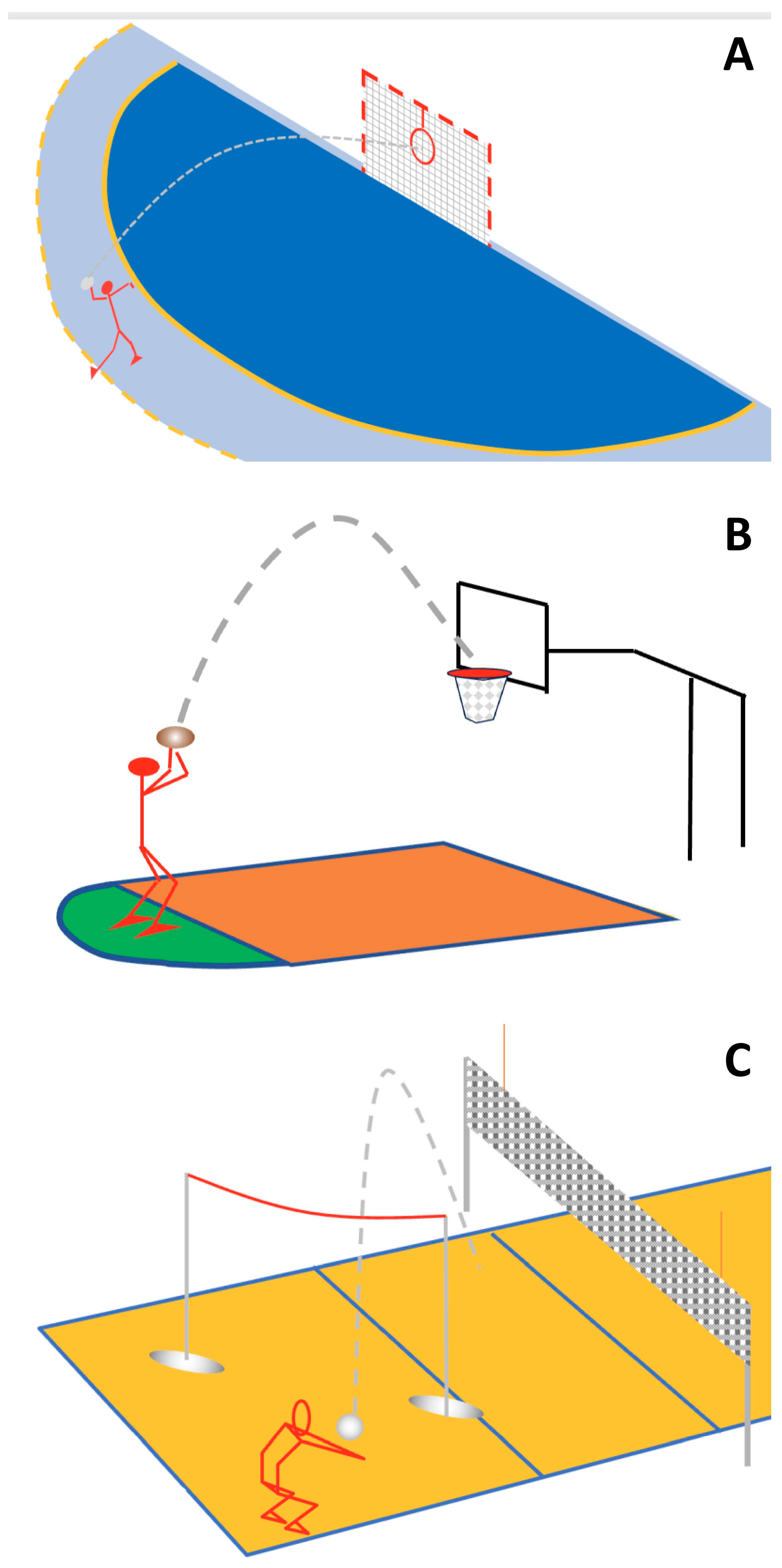
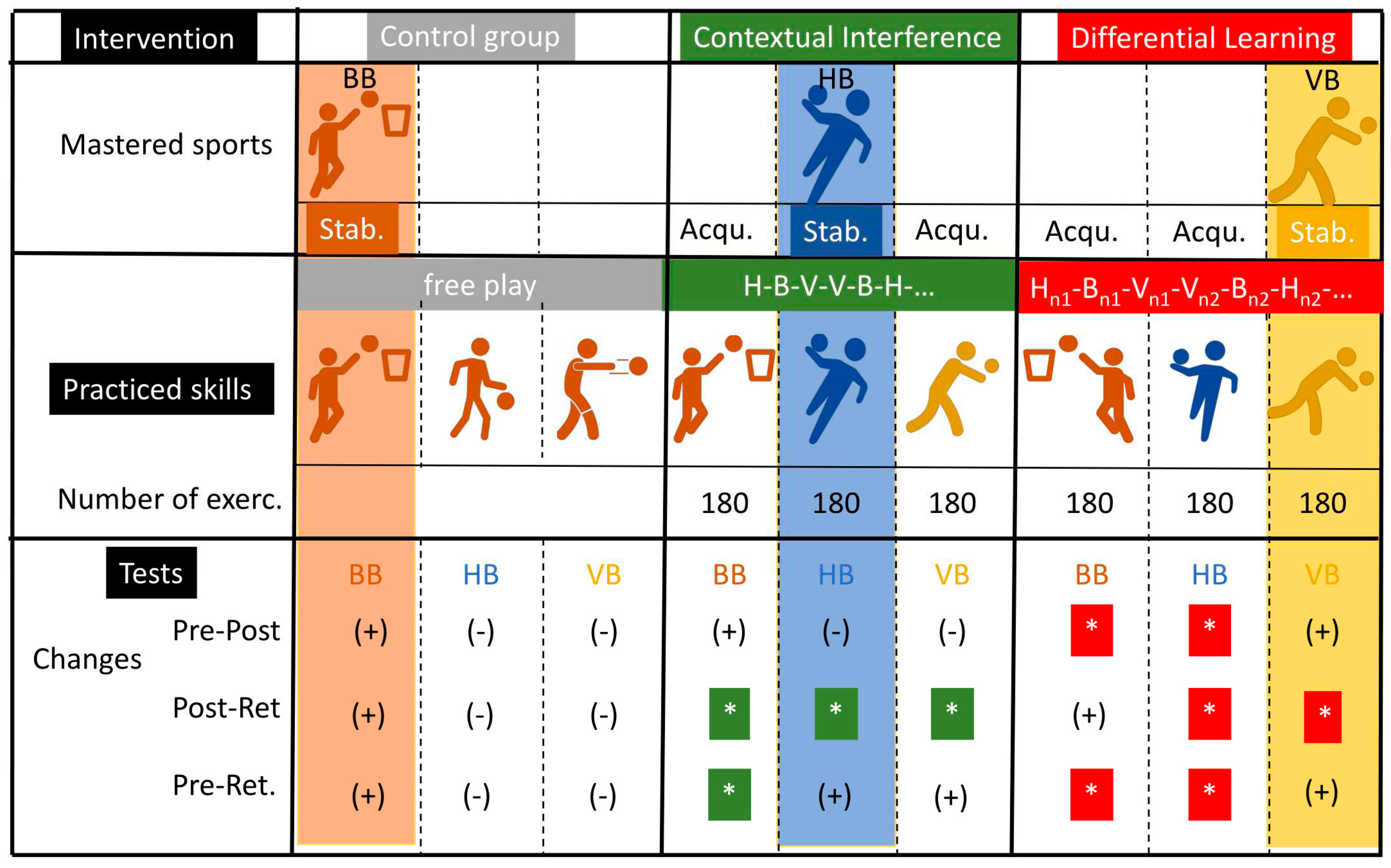
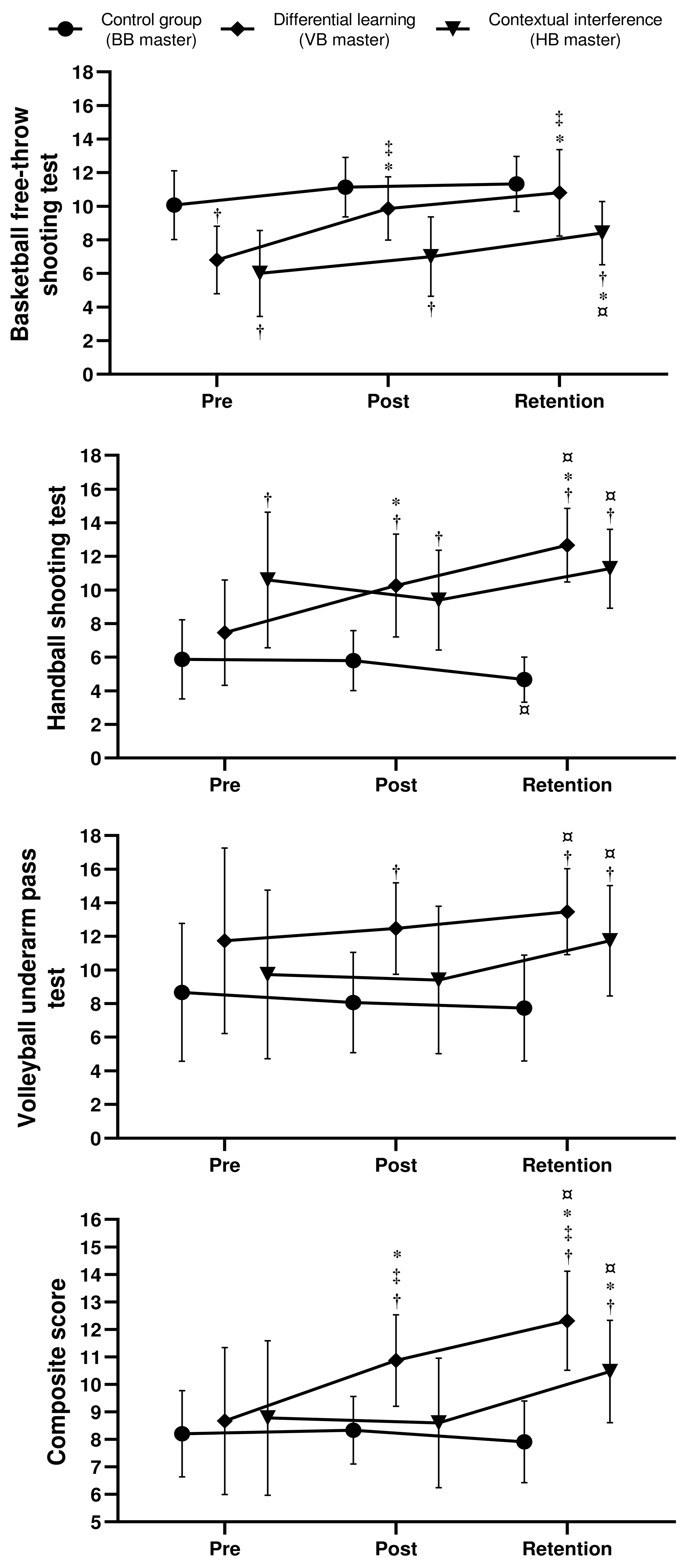
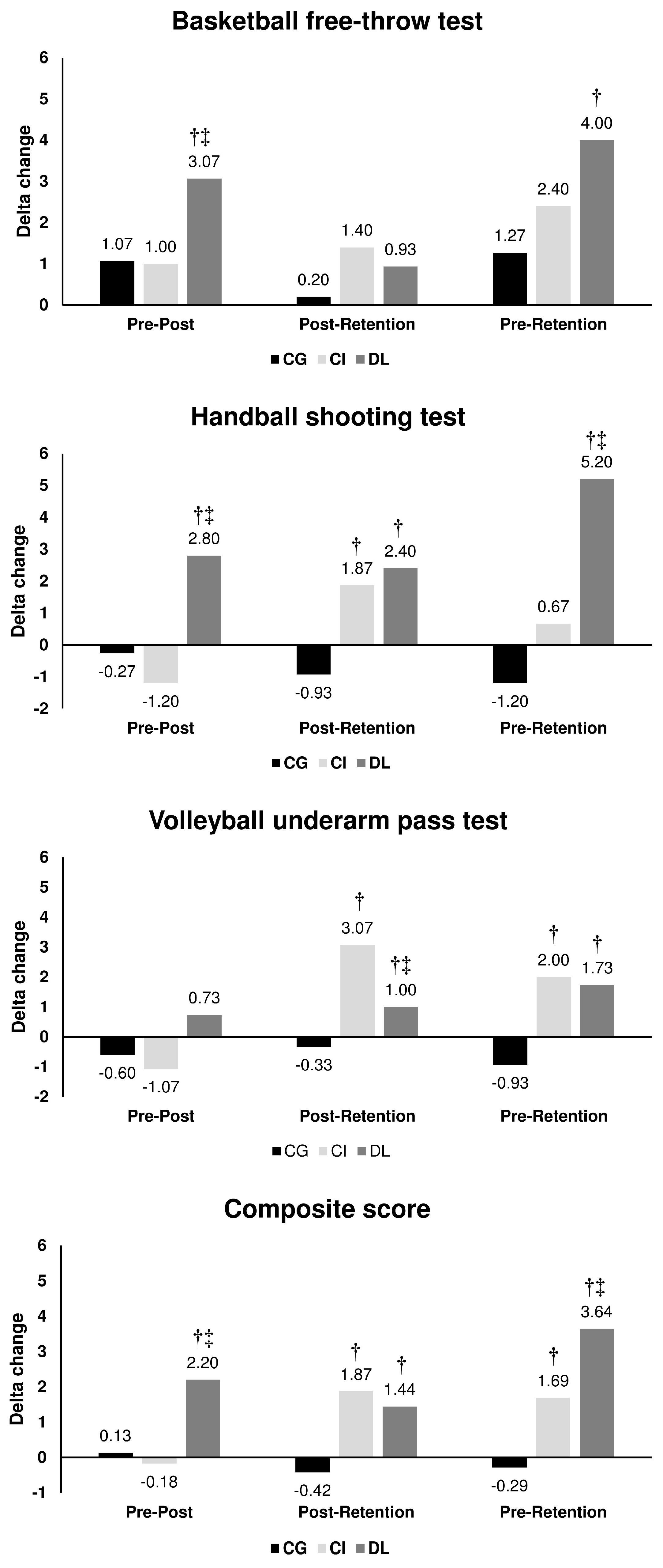
Disclaimer/Publisher’s Note: The statements, opinions and data contained in all publications are solely those of the individual author(s) and contributor(s) and not of MDPI and/or the editor(s). MDPI and/or the editor(s) disclaim responsibility for any injury to people or property resulting from any ideas, methods, instructions or products referred to in the content. |
© 2023 by the authors. Licensee MDPI, Basel, Switzerland. This article is an open access article distributed under the terms and conditions of the Creative Commons Attribution (CC BY) license (http://creativecommons.org/licenses/by/4.0/).




